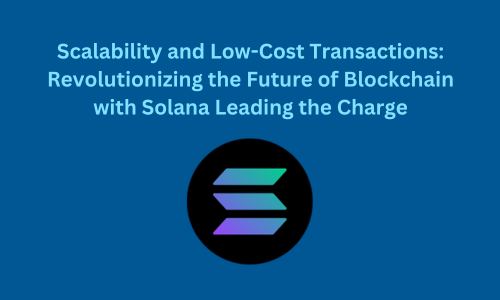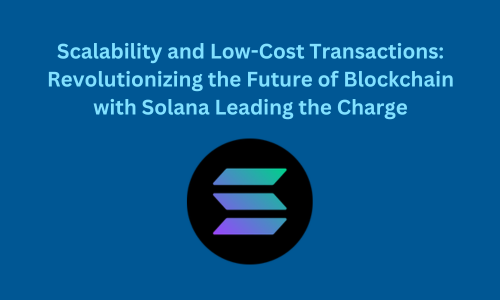


The decentralized blockchain space is at a critical juncture, where its potential to disrupt industries such as finance, gaming, supply chain, and more is within reach. However, one fundamental barrier stands in the way: scalability. As blockchain technology expands, the challenge of handling millions of transactions while maintaining low costs and quick processing times becomes more urgent.
Enter Solana, one of the most promising Layer 1 blockchains, which has emerged as a key player in solving these issues. Solana's ability to process thousands of transactions per second (TPS) at a fraction of a cent has set a new benchmark for the blockchain industry. But what makes scalability and low-cost transactions so revolutionary? Let’s explore why these concepts are essential for the future of blockchain.
Blockchain technology has made significant strides in the last decade, but scalability remains one of its largest hurdles. Most traditional blockchains, such as Bitcoin and Ethereum, were built with security and decentralization in mind, often at the expense of transaction speed and scalability.
As more decentralized applications (dApps) emerge—whether in the realms of decentralized finance (DeFi), non-fungible tokens (NFTs), or supply chain management—the need for a scalable infrastructure has become paramount. Current blockchains, when congested, face sky-high transaction fees and slow confirmation times, creating a frustrating user experience. These limitations impede the widespread adoption of blockchain technology by both developers and everyday users.
Solana, launched in 2020, has quickly gained recognition for its unique approach to scalability. Unlike traditional Proof of Work (PoW) or Proof of Stake (PoS) blockchains, Solana employs a novel consensus mechanism known as Proof of History (PoH). This technology allows the blockchain to timestamp transactions efficiently, enabling thousands of transactions to be processed in parallel, vastly improving throughput.
Currently, Solana can handle over 65,000 transactions per second (TPS) with fees as low as $0.00025 per transaction. This is a massive leap compared to Ethereum, where transaction fees can skyrocket to $100 or more during periods of congestion. Solana’s near-instant transaction finality, coupled with ultra-low fees, addresses two critical pain points in the blockchain space—making it an attractive option for developers and users alike.
The "Scalability Trilemma," a term coined by Ethereum co-founder Vitalik Buterin, describes the trade-offs blockchain networks face between decentralization, scalability, and security. Achieving all three simultaneously is incredibly difficult; most blockchains excel in two areas at the expense of the third.
Solana tackles this trilemma by introducing innovative technologies like Proof of History (PoH) and Tower BFT (Byzantine Fault Tolerance), which work in conjunction to maintain security and decentralization while achieving unprecedented scalability. Unlike Ethereum's reliance on Layer 2 solutions to offload some transactions from the main chain, Solana achieves its scalability directly on its Layer 1 protocol. This makes it unique among blockchains, positioning it as a frontrunner in the scalability race.
Solana's ability to scale has led to a flourishing ecosystem of decentralized applications. Notable projects within its ecosystem include:
These real-world use cases highlight how scalable and low-cost blockchains can transform various industries, providing smoother user experiences and facilitating innovation.
The blockchain revolution is largely dependent on whether the technology can become as ubiquitous and easy to use as traditional web applications. For this to happen, low-cost transactions are a non-negotiable requirement. High transaction fees, as seen in Ethereum during times of congestion, create friction for users, especially those engaging in small-scale transactions or micro-payments.
Low-cost transactions not only make decentralized finance and gaming more accessible, but also open up new opportunities, such as:
While Solana has made impressive strides, it's essential to recognize that it’s not the only solution in the blockchain scalability landscape. Avalanche, Binance Smart Chain, and Cardano are other Layer 1 blockchains offering scalability solutions, though each takes a different approach to consensus mechanisms and trade-offs between decentralization and speed.
On the other hand, Layer 2 solutions like Ethereum’s Optimism and Arbitrum work by processing transactions off the Ethereum main chain and then settling them back on the main chain. While these Layer 2 solutions help scale Ethereum, they come with added complexity, and users still need to bridge assets between Layer 1 and Layer 2. Solana’s high throughput on its native Layer 1 eliminates this additional friction.
While Solana has made significant progress, challenges remain. Network outages have been a concern, with the blockchain experiencing downtime due to overwhelming traffic. However, the Solana development team is continuously upgrading the network to address these issues and ensure its long-term reliability.
Furthermore, while Solana has a much lower environmental impact than Proof of Work systems like Bitcoin, some critics argue that the sheer volume of transactions processed could still pose sustainability concerns as adoption grows. That said, the Solana Foundation is actively working towards carbon neutrality, recognizing the need for sustainable blockchain solutions.
Despite these challenges, the opportunity that scalable and low-cost blockchains like Solana present is immense. By solving scalability issues, the decentralized blockchain space can unlock a new era of applications that were previously impossible to implement at scale.
The ability to process super-fast, low-cost transactions will be a game changer for the blockchain industry, enabling mass adoption across various sectors. Solana’s innovations in scalability and transaction efficiency are proving that decentralized systems can be as fast and affordable as their centralized counterparts.
As more developers, businesses, and users migrate to scalable platforms like Solana, we are likely to witness an explosion of new applications and use cases, from DeFi and NFTs to gaming and beyond. Scalability, coupled with low transaction fees, is the key to making blockchain technology truly transformative—and Solana is leading the charge into this exciting future.
Disclaimer: This article is provided for informational purposes only. It is not offered or intended to be used as legal, tax, investment, financial, or other advice.
